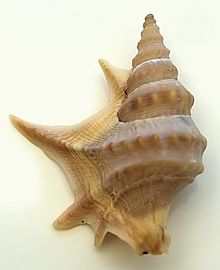Aporrhaidae
| Aporrhaidae | |
|---|---|
 |
|
| A shell of Aporrhais pespelecani, from Catalonia, Spain | |
| Scientific classification | |
| Kingdom: | Animalia |
| Phylum: | Mollusca |
| Class: | Gastropoda |
| (unranked): |
clade Caenogastropoda clade Hypsogastropoda |
| Superfamily: | Stromboidea |
| Family: |
Aporrhaidae Gray, 1850 |
| Species | |
|
See text |
|
| Synonyms | |
|
|
clade Hypsogastropoda
clade Littorinimorpha
See text
Aporrhaidae is a family of sea snails commonly called the "pelican's foot snails." The taxonomy of the Gastropoda by Bouchet & Rocroi, 2005 categorizes Aporrhaidae as marine gastropod mollusks in the clade Littorinimorpha.
Aporrhaids are commercially important, especially in traditional fisheries.
Aporrhaids have a large lip with finger-like extensions, and a small operculum. They do not have movable eyes. Instead, their eyes are fixed at the base of each tentacle.
The mollusk has one narrow foot, which renders its motion interrupted as the foot must raise the shell a tiny bit in each single movement, simultaneously pushing it forward. The motion must be repeated again and again for the mollusk to travel.
Aporrhaidae live on muddy and sandy bottoms, sometimes in very large populations.
Subfamilies in the family Aporrhaidae include:
There are only two Recent genera:
Fossil genera within the family Aporrhaidae include:
...
Wikipedia
